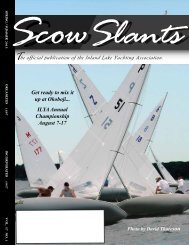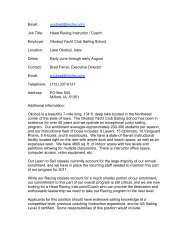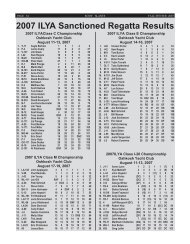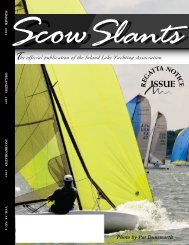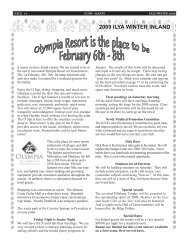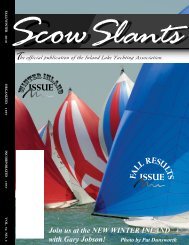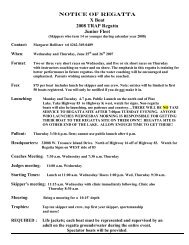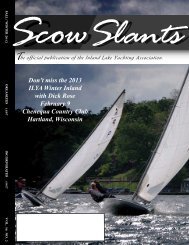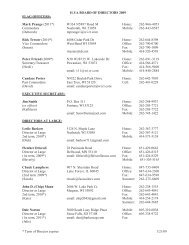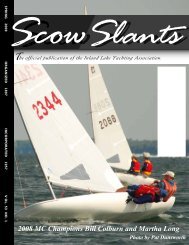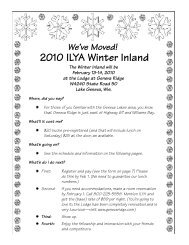35968 Scow Fall Winter - Inland Lake Yachting Association
35968 Scow Fall Winter - Inland Lake Yachting Association
35968 Scow Fall Winter - Inland Lake Yachting Association
Create successful ePaper yourself
Turn your PDF publications into a flip-book with our unique Google optimized e-Paper software.
FALL/WINTER 2006<br />
Speedy A <strong>Scow</strong>s<br />
(continued from page 10)<br />
SCOW SLANTS PAGE 35<br />
was challenging for the lead right next to scow, Olympic and<br />
America’s Cup legend Buddy Melges. Porter and Melges led<br />
all the way to the leeward gate and then the wind stopped,<br />
allowing the rest of us to catch up. It was a mighty big mess as<br />
the 28 scows converged. Somehow Porter snaked through<br />
using a smaller, easier to fly spinnaker than most of the fleet<br />
and went on to win the race and the regatta.<br />
The scow design was first developed for the<br />
Seawanaka Corinthian Cup over 100 years ago. The design<br />
then migrated to Canada before being adopted in the Midwest.<br />
The shallow hull, 1850 pound boat is well suited for flat water<br />
sailing. In the early days A <strong>Scow</strong>s were moved to regattas on<br />
hay wagons and even railroad cars. Rigs evolved from gaff-rig<br />
to carbon fiber mast sloops. These boats sail best when heeled<br />
over at least 20 degrees. They are easy boats to steer, although<br />
hard to sail well. My tactician and main trimmer John Dennis<br />
has sailed scows for years and kept encouraging me to heel it<br />
over more.<br />
In a breeze, it takes a lot of courage to “heel it over<br />
more.” The boat rocks up and you feel that you are about to be<br />
catapulted out of the cockpit. But a subtle tug on the tiller, a<br />
slight ease of the main and spinnaker and zingo, you are<br />
sailing at 25 knots! On the runs two boats close at 50 knots.<br />
You can’t see through the spinnaker with its foot just touching<br />
the water. So you must be aware of the location of every boat.<br />
This was the largest gathering of A <strong>Scow</strong>s in its 107 years of<br />
history. The experience was unique for all 200 crew. What a<br />
thrill to be part of it.<br />
One of the reasons A <strong>Scow</strong>’s popularity has taken off<br />
is the upgrading of the sail plan and use of modern technology<br />
in construction. Other older classes should consider following<br />
the example set by the <strong>Inland</strong> <strong>Lake</strong> <strong>Yachting</strong> <strong>Association</strong>.<br />
The smaller 28' E <strong>Scow</strong> class should consider<br />
updating the spinnaker arrangement with the asymmetrical.<br />
The new A <strong>Scow</strong>s are faster, easier to sail and safer. The older<br />
boats have all been upgraded with retractable bowsprits. The<br />
Melges clan, Harkens and many other Midwest sailors with<br />
innovative thinking have made this boat special. I think A<br />
<strong>Scow</strong>s would perform well on many bodies of water. They are<br />
exciting to sail and watch. A <strong>Scow</strong>s are not cheap. A new<br />
boat, with trailer, sails and covers costs about $138,000. Used<br />
boats are about half that amount.<br />
There is no crew weight limit, so depending on the<br />
strength of the wind 5 to 7 crew are piled on the rail. Sailors<br />
rotate on or off in between races. The key to performing well<br />
is good teamwork. At the prize giving John Porter pointed out<br />
that he and his brother Brian had been racing together for 28<br />
years. In contrast, our crew of J.D., Peter, Jesse, Holly, Dave,<br />
Mike and I had an hour to figure it all out.<br />
The scene at the host <strong>Lake</strong> Geneva Yacht Club was<br />
fascinating to watch. All 28 boats were launched with great<br />
efficiency. Buddy Melges designed the system so that two<br />
boats could be launched at once and trailers could be moved<br />
around a U shaped road. It was a quiet, businesslike<br />
atmosphere. There is great respect between sailors, although<br />
there are strong tribal rivalries between the inland lake clubs.<br />
Each lake is represented by a letter designation on the<br />
sails. This tradition was started during the days of cotton sails.<br />
Reversible letters were used so a backwards letter would not<br />
show through the sail. Many owners have vehicle license<br />
plates with their boat’s sail numbers. Buddy Melges drives a<br />
car with “I-1” plates. Most crews wear team uniforms. And<br />
yes, winning is important. After each day’s racing, dozens of<br />
crew watched Steve Palm’s GPS based sail track to review the<br />
race.<br />
The names of the boats reflected the speed of the<br />
boats. Some examples included: Adrenaline, Full Throttle, G<br />
Force, Slingshot, Catapult, Fast Forward, and Buck’n A. Our<br />
boat, owned by long time scow sailor Coleman Norris, was<br />
called Blue Ribbon in honor of a Milwaukee beer. My crew<br />
also drank a Blue Ribbon in between races. One boat had an<br />
appropriate name, Breakout-Another Thousand.<br />
One of the most terrifying moments in an A <strong>Scow</strong><br />
race is screaming toward the leeward mark at 20 plus knots<br />
and using a Mexican takedown. I threw the double tillers over<br />
and hoped for the best. The crew executed the tough maneuver<br />
perfectly (even after the Blue Ribbon beer). On one downwind<br />
leg we passed an anchored boat filled with cheering bikini<br />
clad sunbathers. We were at full speed. My crew later thanked<br />
me for providing the show.<br />
During the regatta our jib trimmer, Peter Crawford<br />
premiered a film, The Ultimate Ride. He spent two years<br />
searching for material to celebrate this storied class. A crowd<br />
of over 500 showed up to see this film that featured 107 years<br />
of A scow sailing. One of my favorite parts of the movie was<br />
Hermann Nunnemacher’s story of racing an A <strong>Scow</strong> in the<br />
Chicago to Macinac Race. They broke their compass and went<br />
the wrong way for the first night. A couple kids in a power<br />
boat got Hermann’s boat back on track and they still ended up<br />
third boat to finish. (note: the film is available at<br />
www.theultimateridethemovie.com)<br />
<strong>Scow</strong> sailors are used to 1-2 mile legs. But for Race<br />
Four, Ken Legler set an unusually long 3.4 mile windward leg<br />
in 12 knots of wind. It took 28 minutes to reach the top mark<br />
and only 10 minutes to sail downwind. That is a 20.4 knot<br />
VMG for the run! Crewing on these boats can be exhausting.<br />
Only two races were scheduled per day. I wondered out loud<br />
whether we should have a third race. My crew suggested<br />
maybe I should trim the spinnaker? I got the idea.<br />
The day after the regatta, Buddy Melges took my<br />
wife, Janice, and I for a Sunday morning tour of Melges Boat<br />
Works. Buddy jokes that Zenda, WI is not the end of the<br />
world but you can see it from there. It is a good description.<br />
The Boat Works is out in the middle of corn country. Just as<br />
our tour was ending, an old car towing an I-20 came rambling<br />
up the dusty road. Apparently a spreader bar was broken. The<br />
crew had driven down from Madison and needed help. The<br />
shop was closed, but Buddy hung around to jury-rig a fix. The<br />
moment speaks volumes about the work ethic of people in the<br />
Midwest.<br />
The A <strong>Scow</strong> is a class that spans many generations. I<br />
bet the sailors of a century ago would appreciate the advances<br />
of these speedy designs. It makes me wonder how these boats<br />
will evolve going forward?<br />
Aboard Blue Ribbon, we ended up 12th. I came away<br />
with an appreciation for a magnificent race boat that has stood<br />
the test of time.



